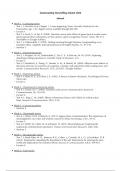Summary
Volledige samenvatting Storytelling Animal
- Course
- Institution
Deze samenvatting bevat alle stof van de hoorcolleges en literatuur die wordt behandeld in de cursus Storytelling Animal. Ik raad aan deze samenvatting aan het begin van het blok te gebruiken om sneller grip te krijgen op de theorie. De samenvatting bevat alle aantekeningen van de hoorcolleges (en ...
[Show more]




